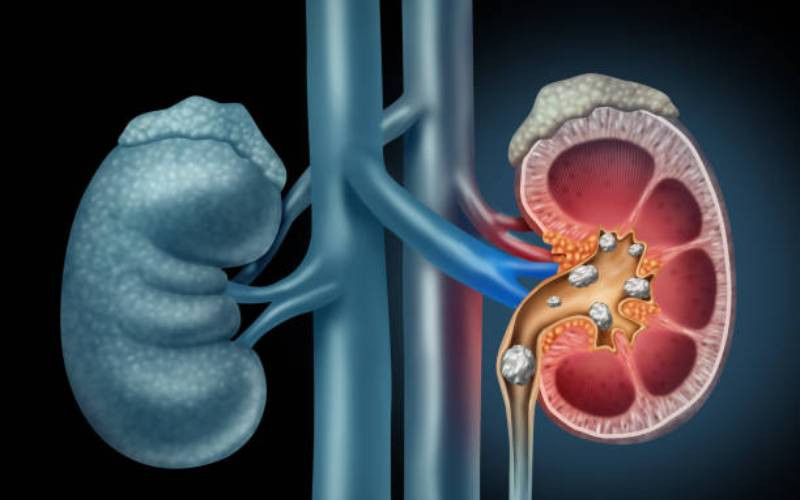
Minerals inside the kidneys crystallise to produce kidney stones. They then get larger and transform into kidney stones. Urinary tract stones can travel from kidney stones. There, they may result in discomfort and blood in the urine (pee). Some stones can also stop the flow of urine.
The majority of kidney stones leave the body without doing any harm. Most kidney stone sufferers find relief with painkillers and plenty of fluids.
Typically, kidney stones do not present symptoms until they pass through the ureter or migrate around in the kidney (the muscular tube that connects the kidney to the bladder). Small stones can leave the body with little to no discomfort.
Larger urinary stones may become lodged and cause symptoms.
As the stones migrate through the urinary tract, the discomfort begins in the side or back and progresses to the lower belly and groin. It comes and goes in waves and is accompanied by blood in the urine (hematuria) nausea, vomiting, a constant or urgent need to urinate, fever or chills (signs of a possible infection).
Urine can sometimes back up when a stone is too large to move. This may cause one or both kidneys to enlarge, resulting in back and side pain. If left untreated, it may harm the kidneys permanently.
Most children and teenagers who develop kidney stones have a medical issue that makes them more likely to do so. TFor instance, some medications require particular diets, such as the ketogenic diet, which is occasionally used to stop seizures.
Diabetes, obesity, issues with the development of the urinary tract and metabolic diseases (problems with how the body breaks down and uses food). Further renal issues. Diseases affecting the parathyroid or thyroid glands. A few urethral infections (UTIs).
Other factors that can increase the likelihood of kidney stones include: Not getting enough liquids, consuming excessive salt, inadequate levels of citric acid (the acid found in citrus foods like oranges) or calcium in the urine.
Most persons who get kidney stones are adults. However, young people can get them. Having a relative who has kidney stones can increase a person’s risk of developing certain forms of kidney stones. Kidney stones are more likely to recur in teenagers who have already experienced them.
How kidney stones treated:
The type of kidney stone and its size affects the course of treatment. Some people can pass a kidney stone by just drinking a lot of water and taking painkillers. For those who have larger stones, surgery or other therapies may be necessary.
Stones come in varieties. It is possible to identify the type of stone by testing urine that contains the stone and is trapped in a strainer. Knowing that can aid doctors in determining the source, guiding how to treat it and help avoid further stones.
At-Home Care
Stay informed. Subscribe to our newsletter
To relieve the pain, drink a lot of water and take medication.
Surgical Intervention
Hospital care may be required for teenagers or children with kidney stones that clog the urinary tract, cause excruciating pain or induce dehydration. To help the stones pass and treat dehydration, they might receive intravenous (IV) fluids and pain medication.
Large stones hardly ever pass by themselves. Doctors can perform a technique to break up the stone to remove huge stones and stones that are harming the kidneys. This enables the smaller bits to pass naturally or to be removed during surgery or through a scope.
 The Standard Group Plc is a
multi-media organization with investments in media platforms spanning newspaper
print operations, television, radio broadcasting, digital and online services. The
Standard Group is recognized as a leading multi-media house in Kenya with a key
influence in matters of national and international interest.
The Standard Group Plc is a
multi-media organization with investments in media platforms spanning newspaper
print operations, television, radio broadcasting, digital and online services. The
Standard Group is recognized as a leading multi-media house in Kenya with a key
influence in matters of national and international interest.
 The Standard Group Plc is a
multi-media organization with investments in media platforms spanning newspaper
print operations, television, radio broadcasting, digital and online services. The
Standard Group is recognized as a leading multi-media house in Kenya with a key
influence in matters of national and international interest.
The Standard Group Plc is a
multi-media organization with investments in media platforms spanning newspaper
print operations, television, radio broadcasting, digital and online services. The
Standard Group is recognized as a leading multi-media house in Kenya with a key
influence in matters of national and international interest.









